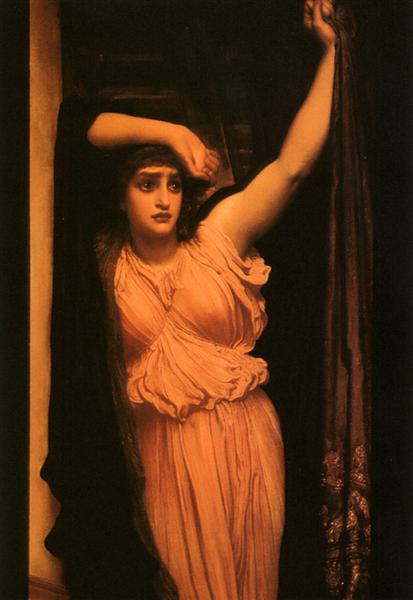Description
Frederic Leighton's The Hero's Last Watch (1880) stands as a moving visual narrative that combines the artist's technical mastery with deep emotional overtones. In this painting, Leighton, one of the foremost exponents of the Pre-Raphaelite movement and Victorian art, takes us into a world filled with courage, sacrifice and the majesty of the hero in a narrative that captures both the greatness and vulnerability of the human being.
The composition of the painting is notable for its balanced arrangement and careful attention to detail. At the centre of the work, we find the hero, a warrior who seems to be making a final contact with his destiny. His figure is surrounded by an environment that can be interpreted as a desolate landscape, where the sombre tone of the background further highlights the central figure. This use of negative space not only emphasises the desperation of the moment, but also grants the hero a sense of monumentality. The subtle lighting, with shadows playing across his body, adds dramatic depth, making the viewer feel the imminent arrival of his destiny, while the light seems to emanate from the figure itself, suggesting his dignity despite adversity.
The colours in The Hero's Last Watch are equally significant. Leighton employs a palette that moves between warm and cool tones, which adds richness and complexity to the work. The gold and terracotta hues that predominate in the hero contrast with the blues and greys of the background. This play of colours not only creates a melancholic atmosphere, but also acts as a symbol of the hero's internal struggle, reflecting the conflict between hope and despair.
Among the interesting aspects of the painting is its exploration of common themes in Leighton's work, such as heroism, nobility and tragedy. Although the figure of the hero may evoke characters from classical mythology or literature, Leighton's focus on the emotionally charged and vulnerable individual allows the work to transcend its historical context. This feature can be seen as an echo of Victorian idealism, which often celebrated the individual in his struggle against a hostile world.
Furthermore, Leighton's style, which combines influences from neoclassicism with romanticism, as well as her clear training in the handling of color and form, is imparted in this piece. Her technique is characterized by soft edges and meticulous attention to texture, creating a sense of movement and life that continues to inspire contemporary critics and painters alike.
While “The Hero’s Last Watch” may not be as well known as some of his other works, it is a notable example of Leighton’s talent for capturing the human spirit and the struggle of the individual in the face of adversity. In an age where heroic representation was intertwined with the search for a national identity and collective morality, this work calls for reflection on the human condition, taking the viewer into a contemplative space where history meets raw emotion. With each viewing, the work invites contemplation of our own fragility and greatness, offering an artistic experience that resonates through time.
KUADROS ©, a famous painting on your wall.
Hand-made oil painting reproductions, with the quality of professional artists and the distinctive seal of KUADROS ©.
Painting reproduction service with satisfaction guarantee. If you are not completely satisfied with the replica of your painting, we will refund 100% of your money.

